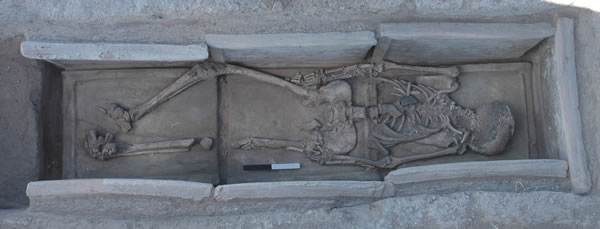FINDS - Human Remains
We were joined by our new Human Remains Team leaders this season: Simon Hillson from the Institute of Archaeology, UCL; and Clark Larsen from Ohio State University. Both spent time on site digesting the corpus of data they have inherited from their predecessors Peter Andrews and Theya Molleson, Natural History Museum. Peter and Theya completed their phase of work with the forthcoming publications and opted to retire to work on their backlog of projects. We thank them both and wish them well. A total of 59 individuals were excavated this field season . Excavations in three areas of the East mound (4040, TP, South) yielded 27 late Roman/Byzantine inhumations, 30 Neolithic and 2 indeterminate ones. All the late burials were uncovered from excavations in the 4040 and TP Areas. The Neolithic burials were recovered from excavations in the 4040 and South Areas. Disturbance to the burials came from several factors, including animals, roots, erosion, and humans. Human disturbance was in the Neolithic in some instances, the late Roman/Byzantine times in others, and even more recently for other burials. The late burials (Late Roman/Byzantine) were represented by four types of graves: 1-Simple soil graves
Figure 37. Classical period adult female burial on an E-W alignment. A small gold loop, a metal disc, a glass vessel, a worked and polished stone plaque and a concentration of numerous small nail like objects were buried with this individual.
2-Tile lined graves
Figure 38. Late period juvenile (10-12 years old), was buried in a Roman roof tile lined grave.
3-Mud-brick lined graves4-Simple soil graves with diagonally placed mud-bricks as grave markersAlmost all of the late Roman/ Byzantine burials were dorsally extended, oriented east-west with the head pointing to the west with the feet to the east. Two adolescents were in their graves extended on their right side, not the back. Two others were slightly off the east-west orientation. Almost all of the graves contained iron coffin nails, coffin wood remains and in some cases wooden posts. Two graves were disturbed: one had no bones in it; the other had only a few scattered bones in it. These empty or nearly empty graves may be due to grave robbery although severe animal disturbance cannot be ruled out. Grave goods were associated with six of the late burials. These included glass vessels, bone objects, a copper disk, stone objects, clay vessels, a copper earring, and a copper needle, and a small gold ornamental piece that may be an earring fragment. A minimum of thirty individuals from the Neolithic were found in the 4040 and South Areas. Twenty-five of these were single primary inhumations. Five burial features had more than one individual in the feature in various degrees of disturbance. The Neolithic burials were all in a flexed position with some variation on the degree and nature of the flexion. One male skeleton was found on his back with the legs flexed on the chest. In some cases, bodies found in less common positions were also associated with phytolith remains, suggesting that some of these bodies may have been buried in baskets. |

